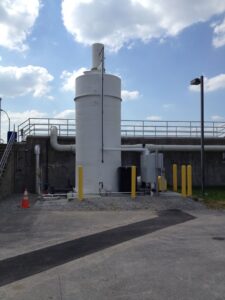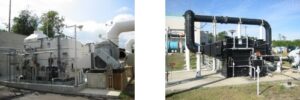Biotrickling Scrubbers and Chemical Scrubbers: How to Choose the Right Fit for Your Facility
 At Webster Environmental Associates, we work with a wide range of industrial and municipal clients who face complex odor control challenges. One of the most common questions we receive is whether to use biotrickling scrubbers, chemical scrubbers, or a combination of both. The right answer depends on the nature of the odor, the layout of the site, and long-term operational needs. Together, we’ll walk through how we help clients decide which system is the best match for their goals.
At Webster Environmental Associates, we work with a wide range of industrial and municipal clients who face complex odor control challenges. One of the most common questions we receive is whether to use biotrickling scrubbers, chemical scrubbers, or a combination of both. The right answer depends on the nature of the odor, the layout of the site, and long-term operational needs. Together, we’ll walk through how we help clients decide which system is the best match for their goals.
Different Tools for Different Problems
Every facility faces unique odor issues. Some deal with strong but short-term spikes, while others experience low but steady emissions. The type of odor-causing compounds, the size and shape of the facility, and the airflow all play a role in the industrial odor control solution.
That’s why no single technology works for every case. Biotrickling scrubbers and chemical scrubbers each have clear advantages depending on the situation. At WEA, we work with both and recommend them based on data from the site.
When Chemical Scrubbers Make Sense
Chemical scrubbers are often the right choice when a facility has to treat high concentrations of corrosive gases like hydrogen sulfide. These systems use liquid chemicals to react with the gas and remove it from the air quickly. They are especially effective for managing odor spikes and responding to sudden increases in gas levels.
Chemical scrubbers also respond faster than biological systems, which makes them helpful in applications where the gas load can change quickly. If a site cannot afford downtime and needs consistent odor removal at all times, a chemical scrubber may be the most reliable option.
When Biotrickling Scrubbers Are the Better Fit
Biotrickling scrubbers use microorganisms to treat odorous air. These systems are most effective when the gas flow and composition are stable. They don’t require hazardous chemical storage and can provide long-term savings through lower operating costs.
They work best on biodegradable compounds and can remove odors effectively with less manual oversight. However, biotrickling scrubbers do require balanced conditions to stay healthy. If airflow, moisture, or pH levels fall outside the right range, the system can lose performance.
That’s why we recommend biotrickling scrubbers at sites where those operating conditions can be met and maintained.
Operational Considerations
Choosing between biotrickling scrubbers and chemical scrubbers also means looking at how your team will maintain the system. Chemical scrubbers require regular delivery and handling of treatment chemicals, plus storage space and safety procedures. Biotrickling systems rely on media beds and irrigation systems, which need routine checks to keep biological activity stable.
Staffing and training also matter. If your team has limited availability for chemical handling or media maintenance, that may influence the best choice. And while chemical scrubbers may have a higher operating cost over time, biotrickling scrubbers may have a higher upfront cost and require a longer time to stabilize after installation.
We help clients walk through these trade-offs to find the most practical match for their team and budget.
Case-by-Case Blended Systems
 Some facilities benefit from using both biotrickling and chemical scrubbers in the same system. This approach is helpful when a site has a mix of steady emissions and unpredictable spikes. For example, we worked with a municipal wastewater facility that had steady baseline hydrogen sulfide levels with occasional sharp increases.
Some facilities benefit from using both biotrickling and chemical scrubbers in the same system. This approach is helpful when a site has a mix of steady emissions and unpredictable spikes. For example, we worked with a municipal wastewater facility that had steady baseline hydrogen sulfide levels with occasional sharp increases.
We designed a two-stage system using a biotrickling scrubber to handle the base load and a chemical scrubber to manage the spikes. This allowed the facility to reduce chemical use while still covering all odor conditions. In blended systems like these, we focus on airflow modeling and sizing to make sure both units work efficiently together.
WEA’s Role in System Selection
At Webster Environmental Associates, we don’t push a single product or technology. We start with a site evaluation to understand how odors behave at your facility. That includes air sampling, dispersion modeling, and sometimes odor panel testing. We look at where the odor is coming from, how far it travels, and what compounds are present.
Then we compare options using cost, performance, and layout as key factors. Because we’re not tied to a single manufacturer, we can choose the most effective combination of equipment and controls for each project.
We also support each design with full documentation, layout drawings, and integration planning. Once the system is installed, we help train your staff and provide long-term service for maintenance planning and performance tracking.
Ready to Compare Options? Call WEA
If your facility is dealing with odor issues, it’s important to choose a system that matches your actual operating conditions—not just what looks good on paper. Biotrickling scrubbers and chemical scrubbers both have clear advantages, but they solve different problems.
At Webster Environmental Associates, we guide each client through a clear, data-driven process. Our goal is to match your site with the right tools and provide support from the first call to ongoing performance checks.
Reach out online today to schedule a site walkthrough or a consultation. We’re ready to help you plan a system that works from day one and continues to deliver strong results over time.
